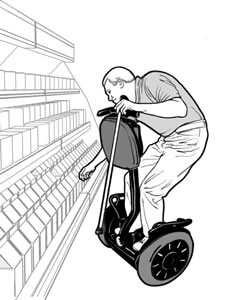ADA Requirements - Wheelchairs, Mobility Aids, and Other Power-Driven Mobility Devices
Requirements Regarding Mobility Devices and Aids
Under the new rules, covered entities must allow people with disabilities who use wheelchairs (including manual wheelchairs, power wheelchairs, and electric scooters) and manually-powered mobility aids such as walkers, crutches, canes, braces, and other similar devices into all areas of a facility where members of the public are allowed to go.
In addition, covered entities must allow people with disabilities who use any OPDMD to enter the premises unless a particular type of device cannot be accommodated because of legitimate safety requirements. Such safety requirements must be based on actual risks, not on speculation or stereotypes about a particular type of device or how it might be operated by people with disabilities using them.
- For some facilities -- such as a hospital, a shopping mall, a large home improvement store with wide aisles, a public park, or an outdoor amusement park -- covered entities will likely determine that certain classes of OPDMDs being used by people with disabilities can be accommodated. These entities must allow people with disabilities using these types of OPDMDs into all areas where members of the public are allowed to go.
- In some cases, even in facilities such as those described above, an OPDMD can be accommodated in some areas of a facility, but not in others because of legitimate safety concerns. For example, a cruise ship may decide that people with disabilities using Segways® can generally be accommodated, except in constricted areas, such as passageways to cabins that are very narrow and have low ceilings.
- For other facilities -- such as a small convenience store, or a small town manager's office -- covered entities may determine that certain classes of OPDMDs cannot be accommodated. In that case, they are still required to serve a person with a disability using one of these devices in an alternate manner if possible, such as providing curbside service or meeting the person at an alternate location.
Covered entities are encouraged to develop written policies specifying which kinds of OPDMDs will be permitted and where and when they will be permitted, based on the following assessment factors.


User Comments/Questions
Add Comment/Question